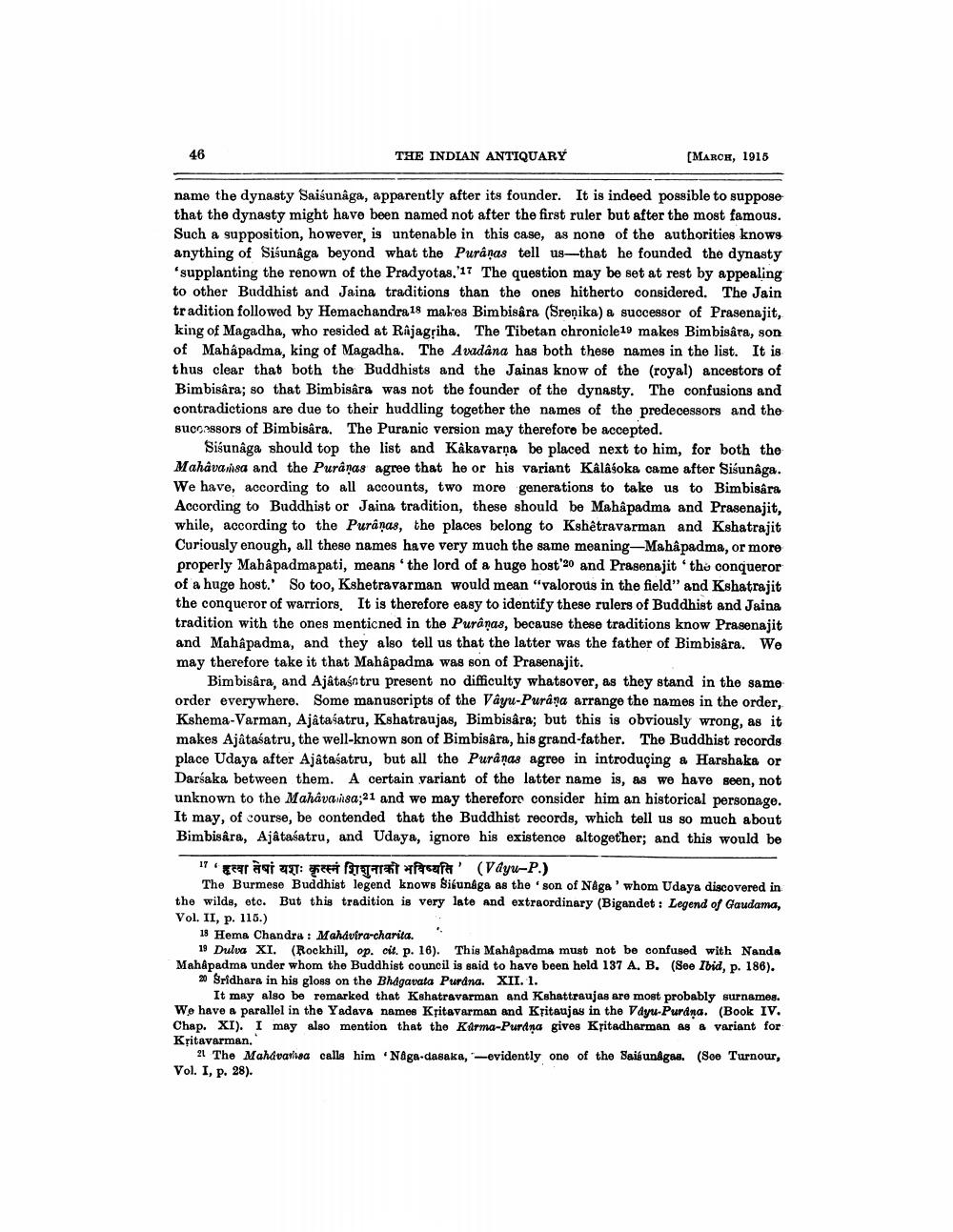________________
46
THE INDIAN ANTIQUARY
[MARCH, 1915
name the dynasty Saišunaga, apparently after its founder. It is indeed possible to suppose that the dynasty might have been named not after the first ruler but after the most famous. Such a supposition, however, is untenable in this case, as none of the authorities knows anything of Sisunaga beyond what the Puranas tell us—that he founded the dynasty 'supplanting the renown of the Pradyotas, '17 The question may be set at rest by appealing to other Buddhist and Jaina traditions than the ones hitherto considered. The Jain tradition followed by Hemachandra 18 males Bimbisára (Sreņika) a successor of Prasenajit, king of Magadha, who resided at Rajagļiha. The Tibetan chronicle 19 makes Bimbisâra, son of Mahapadma, king of Magadha. The Avadana has both these names in the list. It is thus clear that both the Buddhists and the Jainas know of the (royal) ancestors of Bimbisâra; so that Bimbisâra was not the founder of the dynasty. The confusions and contradictions are due to their huddling together the names of the predecessors and the BUCO 880rs of Bimbisåra. The Puranic version may therefore be accepted.
Sisunaga should top the list and Kakavarna be placed next to him, for both the Mahavansa and the Puranas agree that he or his variant Kålásoka came after Sisunaga. We have, according to all accounts, two more generations to take us to Bimbisara According to Buddhist or Jaina tradition, these should be Mahapadma and Prasenajit, while, according to the Puranas, the places belong to Kshetravarman and Kshatrajit Curiously enough, all these names have very much the same meaning-Mahâpadma, or more properly Mahâpadmapati, means the lord of a huge host 20 and Prasenajit the conqueror of a huge host.' So too, Kshetravarman would mean "valorous in the field" and Kshatrajit the conqueror of warriors. It is therefore easy to identify these rulers of Buddhist and Jaina tradition with the ones menticned in the Puranas, because these traditions know Prasenajit and Mahapadma, and they also tell us that the latter was the father of Bimbisara. We may therefore take it that Mahapadma was son of Prasenajit.
Bimbisâra, and Ajâtaśntru present no difficulty whatsover, as they stand in the same order everywhere. Some manuscripts of the Vayu-Purana arrange the names in the order, Kshema-Varman, Ajátasatru, Kshatraujas, Bimbisâra; but this is obviously wrong, as it makes Ajâtasatru, the well-known son of Bimbisára, his grand-father. The Buddhist records place Udaya after Ajátasatru, but all the Puranas agree in introducing a Harshaka or Darsaka between them. A certain variant of the latter name is, as we have seen, not unknown to the Mahavainsa;21 and we may therefore consider him an historical personage. It may, of course, be contended that the Buddhist records, which tell us so much about Bimbisêra, Ajatasatru, and Udaya, ignore his existence altogether; and this would be
11caragi 23: Hi TT faufa' (Vayu-P.)
The Burmese Buddhist legend knows Bifunåga as the son of Naga 'whom Udaya discovered in the wilds, etc. But this tradition is very late and extraordinary (Bigandet: Legend of Gaudama, Vol. II, p. 115.)
18 Hema Chandra : Mahavira-charita.
19 Dulva XI. (Rockhill, op. cit. p. 16). This Mahapadma must not be confused with Nanda Mahapadma under whom the Buddhist council is said to have been held 137 A, B. (See Ibid, p. 186). 20 Sridhara in his gloss on the Bhagavata Purdna. XII. 1.
It may also be remarked that Kshatravarman and Kshattraujas are most probably surnames. We have a parallel in the Yadava names Kpitavarman and Kritaujas in the Vayu Purana. (Book IV. Chap. XI). I may also mention that the Kdrma-Purana gives Kritadharman as & variant for Ksitavarman,
21 The Mahavarisa calls him Naga-dasake, "-evidently one of the Saifun&gas. (See Turnour, Vol. I, p. 28).




